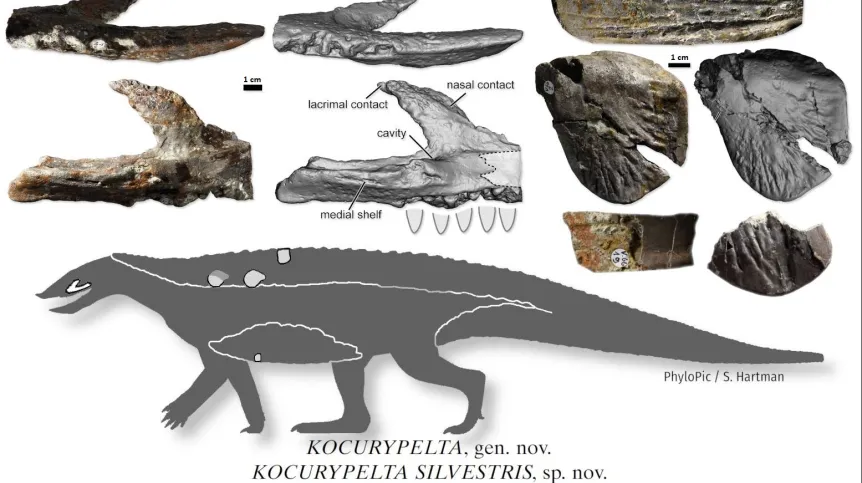
A new species of aetosaur - a prehistoric reptile resembling today's crocodiles – has been discovered in southwest Poland.
The specimen was found among fossils of vertebrates from about 210 million years ago, including lungfish and turtles, excavated at the archeological site in the village of Kocury.
The discovery was made by a team of scientists from the Institute of Paleobiology of the Polish Academy of Sciences and the Faculty of Biology of the University of Warsaw who managed to find the jawbone and fragments of the carapace of the new aetosaur, which was named Kocurypelta silvestris.
Łukasz Czepiński from the Institute of Evolutionary Biology at the University of Warsaw said: "The (jaw) bone is characteristic, because our aetosaur had very few teeth, and the ones it had were shifted towards the front of the skull. We do not recognise this feature in other aetosaurs, most of them have a jaw full of teeth.”
He added: "They looked like a cross between a crocodile, an armadillo and a wild boar... they were about three metres long. Most of them were omnivorous, they ate plants, small invertebrates, but also plant rhizomes."
The first bone of a carnivorous dinosaur found in what is now Poland also comes from the site in Kocury.
At the turn of the 20th century, when the village was within the borders of the German empire, the bone was found by Georg Gürich, a German Paleontologist born in Dobrodzień.
It was then sent to Hamburg, where the famous German Palaeontologist Friedrich von Huene studied it. In 1932, he determined that the bone belonged to a carnivorous dinosaur and described under the name Velocipes guerichi, given in honour of the discoverer.
During subsequent geopolitical changes, Kocury became part of modern-day Poland, which is why the specimen found in the village is considered the first dinosaur bone found in Poland. But the site was forgotten for almost 100 years.
Czepiński said: “Since no excavations have been carried out there, no one was interested in this site. Only that single find from the turn of the century indicated that something interesting could be there.”
Scientists from the University of Warsaw followed this trail and, having re-examined the famous dinosaur bone, decided to return to the site.
Czepiński continued: “With the specimen kept in Hamburg, there were also detailed information about the place where it was found. In 2012, after consulting the local forestry department and the State Forests, we took an excavator for a test run. It turned out that at a relatively small depth there were 210 million-year-old rocks. In these rocks, quite difficult for scientific processing, we found several dozen new fossils.”
At the late Triassic site, researchers also found fragments of the shell of one of the oldest turtles in the world. According to Czepiński, they resemble fragments found in Poręba (also in Poland). This is potentially the same species of prehistoric turtle. They also discovered a dental plate of a lungfish. This large prehistoric form of fish had characteristic teeth, probably for crushing mussels. All these animals probably lived during the same period.
The results of the work have been described in the Journal of Vertebrate Paleontology.
Further publications are planned as researchers already have new finds from the place and hope to find more fossils of the new aetosaur in the future.
Czepiński said: “It would also be great to find bones of a new dinosaur, because we already know that dinosaurs certainly lived there.”
PAP - Science in Poland, Ewelina Krajczyńska
ekr/ zan/ kap/
tr. RL













